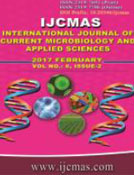


 National Academy of Agricultural Sciences (NAAS)
National Academy of Agricultural Sciences (NAAS)

|
PRINT ISSN : 2319-7692
Online ISSN : 2319-7706 Issues : 12 per year Publisher : Excellent Publishers Email : editorijcmas@gmail.com / submit@ijcmas.com Editor-in-chief: Dr.M.Prakash Index Copernicus ICV 2018: 95.39 NAAS RATING 2020: 5.38 |
A dynamic growth model (CO2FIX) has been used for estimating the Carbon Sequestration Potential of Kafal (Myrica esculenta), an indigenous multipurpose tree used for timber, fuel wood, fiber and in addition to its medicinal value. The present study has been carried out in the campus of V.C.S.G. College of Horticulture, U.U.H.F., Bharsar, Pauri Garhwal, Uttarakhand. The altitude of the location is ranging from longitude 78.59’:20.28’E, latitude 79.00’:30.05’N and 2000 m MSL altitude. The temperature and rainfall of this hilly area ranged from -4.0 to 28.0oC and more than 10000 mm respectively. It is capable of thriving on snow and heavy rainfall condition. CO2FIX was parameterized for a simulation of 100 years respectively. The results indicate that the long term tree biomass accumulated was 112.59 t/ha in Biomass Carbon (Above Ground Biomass) and 71.4 t/ha in Soil Carbon (Below Ground Biomass) component respectively, at the end of simulation period assuming a tree density of 740 t/ha (approximately). The net annual carbon sequestration for Kafal over the entire simulation period was 1.839 Mg C ha-1 yr -1 (t/ha/yr).
 |
 |
 |
 |
 |